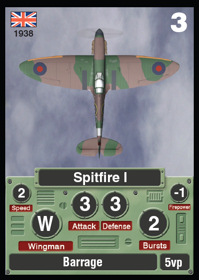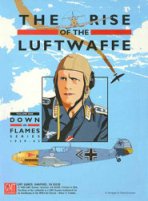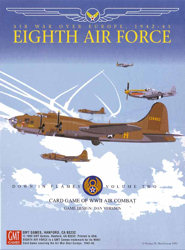
Game: Thunderbolt / Apache Leader: Joint Attack Weapons System
Publisher: GMT Games
Published in: 1991
Designer: Dan Verssen
Era and Topic: Contemporary / Close Air Support combat / Aircraft and attack helicopters
Components: 110 full-color two-sided cards, 300 full-color two-sided counters, one 22×17” full-color combat display, one 10-sided die, 20-page rulebook, Sector Map, Pilot / Crew experience log, aircraft & pilot damage chart
Game Type: Solitaire or coop / card-driven / counters
HFC Game-O-Meter: C 
Our Rating (1-10):
Graphic Presentation: 7
Rules: 7
Playability: 8
Replay Value: 9.5
Overall Rating: 9
| PRO | Can be played solitaire or in cooperative team-play, rules contain background information about CAS warfare, high replayability, various difficulty levels, tactical and strategical level, challenging and tough decision-making required, resource management, clever combat system |
| CONTRA | Rules somewhat cumbersome here and there |
Introduction

Planning, calculating, and conducting CAS missions together is challenging and fun!
We love cooperative games! We enjoy the card game Space Hulk – Death Angel, we love cooperative board games like Arkham Horror or video games like Too Human or Borderlands on Xbox 360. Thunderbolt / Apache Leader isn’t a cooperative team-game in the first place, it is primarily a solitaire game, but it offers variants for cooperative team play, so one weekend we decided to give the game a try… together!
We own a number of solitaire wargames, for example the Ambush series, London’s Burning, B-17, Carrier, Patton’s Best, even SASL (Solitaire ASL) which are designed to be played by one player “against the game system” or Paper AI. Fortunately, many of these games can be played by two players as well who team up against the enemy. And some of these games even offer specific rules or instructions for playing the game cooperatively. A great example is the modern air combat simulation “Thunderbolt / Apache Leader” by Dan Verssen.
This review doesn’t only deal with the coop variant but is a general in-depth review of the game. So if you are a dedicated (or involuntary) solitaire gamer, this review is also for YOU. In addition, we will tell you something about flying cooperatively (which works excellent, btw!), so if you are a fan of wargames supporting team-play, read on!
What is Thunderbolt / Apache Leader?
Thunderbolt / Apache Leader (TAL) is a wargame depicting modern tactical air combat, utilizing a combination of card- and counter-based mechanics and a combination of tactical and strategical planning and gameplay. It was published by GMT Games in 1991 and is part of the “Air Leader series”. Since players have to conduct a good deal of math calculation and consulting of several tables, the game is definitely not a “light wargame”, but effectively a consim with medium complexity.
In the game, the player commands single A-10 Thunderbolt fighter aircraft and AH-64 Apache attack helicopters. In addition, he can use AH-1 Cobra attack helicopters and AV-8B Harrier vertical takeoff fighter aircraft as support. The game is scenario-based and takes place in various cold-war and contemporary hot spots all over the world: Operation Desert Storm Iraq, Korea, Germany, Russia, Libya. The focus lies on air-to-ground combat, but in the course of a campaign, players can also possibly face opposing air units in air-to-air combat.

Operation Desert Storm in full progress
The objective differs with each campaign. Basically, players have to defend their air base and destroy opposing ground forces before they overrun the base. Enemy ground forces consist of various different unit types, for example SAM sites, Anti-Air-vehicles, heavy armored tanks, infantry, APC, or non-armored trucks. In addition, friendly ground forces (AFV and Mechanized battalions) engage the enemy ground forces, but the player’s main task is to provide air support and to soften the ground targets before the friendly ground forces encounter the enemy.
Players can choose between various types of munition for their aircraft. There are three types of attacks, cannon attacks with board cannons, strike attacks with various rocket types (rocket pot, cluster bombs, Mk.82-84), or stand-off attacks with laser-guided missiles (Hellfire, Maverick). A focus lies on resource management; players have only a restricted contingent of “Air base points” with which they have to “pay” aircraft, pilots, and ammunition for each of the daily missions. So you cannot simply put all the cool stuff into your jets and helicopters – you have to plan carefully and in advance if you want to fly and fight another day.

AH-64 "Apache" attack helicopter card
Players also have control over different pilots (jets) or crews (helicopters) with various skills and special abilities. Pilots are humans, though, and suffer from stress during flight missions. Choosing the right pilot for the right task is another challenge of the game. Pilots can get lost or end the day in sick bay or shaken, so they cannot fly the next day. Optional fatigue and experience rules add even more realism to pilot management.
The map (“Combat Display“) is a sheet printed with several tables, turn record tracks, and terrain space which consists of randomly placed terrain cards. You see the combat area from high above – from an aircraft’s perspective. There are two types of combat resolutions each day – a primary (mandatory) mission which is resolved tactically in aircraft vs. single units of ground vehicles, infantry, or enemy aircraft, and a secondary (optional) mission which is resolved strategically by comparing attack and defense strength, troop quality, and several other scenario-specific modifiers.
All in all, Thunderbolt / Apache Leader is a quite simulative game with lots of mathematic calculations and cross-referencing of combat and effect tables. This sounds very technical and dry, but in fact the game accurately portrays air warfare from the perspective of a squadron leader which feels very cool and authentic.
Graphic presentation and production quality
TAL depicts modern air warfare, so the overall game design corresponds with the topic.
The box art shows photos of the A-10, the AH-64, and infantry soldiers during Operation Desert Storm. The box contains a paper map sheet, several additional displays (a sector sheet and the air base sheet), log sheets for pilot fatigue, counters for several game effects, enemy ground units, friendly ground units, ammunition types, combat results. There are several card decks – double-sided aircraft and pilot cards as well as draw decks for random events. Campaigns and combat conditions are also printed on small cards. The design is somewhat technical and abstract, but all in all, the game looks modern.















